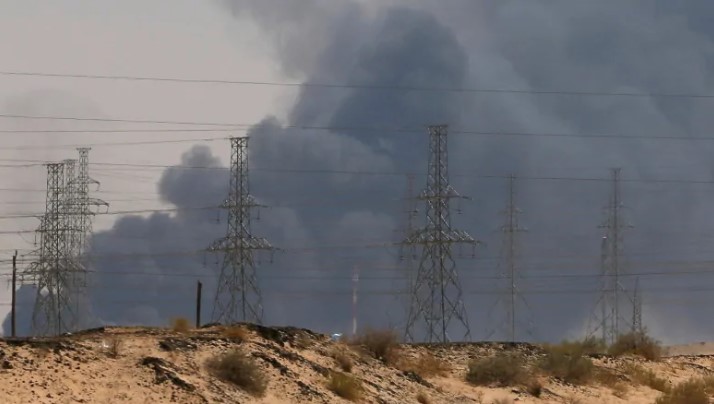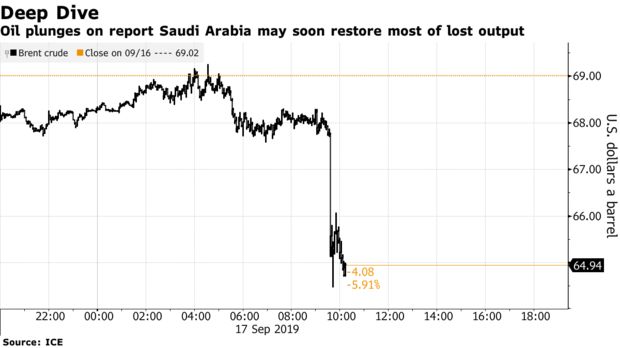- GOLD IRA
- Download Our 2024 Precious Metals IRA Investor’s Guide.
Click Here  Gold IRA
Gold IRA
 Investing
Investing
-
- CRYPTO IRA
- PRICES & STATS
- RETIREMENT PLANS
- BLOG
 Questions? Call (888) 820 1042
Questions? Call (888) 820 1042
Drone Attack on Saudi Oil Facilities Causes Wild Swings in Oil Prices
Disclosure: Our content does not constitute financial advice. Speak to your financial advisor. We may earn money from companies reviewed. Learn more

This past weekend saw a major successful attack on Saudi Arabia's oil production facilities and one of its largest oil fields. It resulted in over five million barrels of oil exports being taken offline. The most severe sudden disruption of world oil supplies of all time caused prices to spike their most ever, rising over 19 percent in seconds on Monday. Geopolitical risk premiums have skyrocketed on fears that oil production in the Middle East is under threat and on the possibility of a retaliatory strike against Iran.
Saudi Oil Fields and Facilities Attacked Over the Weekend
The series of attacks that took place this weekend on Saudi Arabia's massive oil industry significantly disrupted oil production in the kingdom. The country's biggest oil processing facility (located at Abqaiq) and a nearby flagship oil field suffered from major attacks on Saturday. Ten unmanned aerial drones were involved in the surgical assault on the critical processing complex and second largest Saudi oil field.
This attack took 5.7 million daily barrels of crude production offline. It represented over half of the entire Saudi oil output. Initially, Saudi Aramco indicated it could take from several weeks to months to bring the majority of daily output back online at the critical Abqaiq facility.
Abqaiq remains the biggest oil processing facility on earth. It is also the most important crude oil stabilization plant anywhere, thanks to its ability to process over seven million daily barrels of oil. The attacked Khurais oil field is the second biggest one in Saudi Arabia. It has a daily pumping capacity of 1.5 million barrels. For the month of August, Saudi Arabia pumped 9.85 million barrels of oil each day.
This helps to explain how the assault on the Saudi oil facilities could cause the highest ever single day spike and among the wildest sessions of oil trading ever seen. After opening up over 19 percent, the international Brent Crude market settled up an incredible 15 percent higher.
Responses to the Attack on Saudi Arabia Blame Iran
The Saudi Arabian Ministry of Foreign Affairs announced that its early investigations revealed that weapons in the attack were Iranian. Initially they said that “Investigations are still ongoing to determine the source of the attack.” Yet a military coalition led by the Saudis stated that the attack did not come from Yemen as Houthi rebels there claimed, and that Iranian weapons carried out the attack.
Iran all but admitted its complicity when their President Hassan Rouhani claimed that the assault on Saudi Aramco was a “reciprocal response” against aggression (by the Saudi-led coalition) versus Yemen. All eyes turned to the U.S. to see what the administration's response would be. American President Donald Trump stated Monday that he is in no rush to respond to this coordinated attack. President Trump was asked if Iran was responsible for the assault. He responded with:
“It's certainly looking that way at this point. That was a very large attack and it could be met with an attack many, many times larger very easily by our country, but we are going to find out who definitely did it first.”
Oil markets were increasingly nervous waiting to see what response the U.S. might make.
Attack Causes Worst Disruption to Oil Markets Ever
Oil markets reacted by setting a new record for all time greatest price movement and largest single session jump as a result of the attacks. Monday saw the Brent crude oil contract reach $71.95 per barrel when the contract was up 19.5 percent.
This disruption was worse than the two prior shocks to the market seen in 1990 and 1979. In August of 1990, Kuwaiti and Iraqi oil output loss caused a significant disruption. This week's disruption exceeded both that and the disappearance of oil production in 1979 during the Islamic Revolution, per the International Energy Agency.
Saudi Aramco responded by restarting up its offshore oil fields that are idle. These are a portion of the country's spare capacity, but they did not come close to covering the lost production amount. The Saudis did have stockpiles in domestic inventories for 26 days worth of exports, per Rystad Energy A/S a consultant. The kingdom was using this to supply their customers while the production is offline. Some customers were also asked to take a different grade of crude oil than usual.
The estimates for how long it will take the Saudis to get the lost 5.7 million barrels per day of production back online have varied. A large amount of the lost volume should be back within a few days, yet it may still require weeks to bring back the full production capacity. Reuters cited top level Saudi sources (who had been updated on the oil operations) as saying that the full output will be back in from two to three weeks.
After Settling 15 Percent Higher, Oil Prices Swing Lower
Tuesday morning saw oil prices that had settled 15 percent higher on Monday drop back down seven percent. More encouraging news emerged that Saudi Arabia was nearing 70 percent restoration of their oil production. Oil prices also had help from President Trump to move back down. He announced his decision to authorize releasing oil from the Strategic Petroleum Reserve as needed so that markets will remain “well-supplied.” This chart below shows how international oil prices had reacted in the spike up and subsequent pullback:

Oil prices will likely remain volatile in the coming days and weeks. Sevens Report founder Tom Essaye wrote Tuesday that:
“Going forward, the main driver of prices will be time, specifically how long the Saudi production facilities will be offline.”
Brent Crude was back down to under $65 Tuesday morning after the Reuters reports came out from Saudi sources that the OPEC country will reach its full production again in no more than two to three weeks. Saudi Energy Minister Prince Abdulaziz bin Salman was holding a press conference in Jeddah on Tuesday evening to further calm markets. Citi Chief Investment Strategist Steven Wieting reminded investors that there are still long term risks in play, with:
“Geopolitical events have a historic tendency of exaggerated initial impact in markets, with a smaller economic and market impact emerging over a short period of time. The degree of any escalation with Iran is the more critical issue for longer lasting supply risks. Temporary disruptions for repairs inside Saudi [Arabia] are very different.”
Successful Attacks Reveal Vulnerability of Saudi Production and Mideast Oil
Other analysts have warned that the bearish cycle in oil may be over because of long term fears that this attack has raised. The successful attack has demonstrated that Saudi Arabia's key production and Middle Eastern oil supply in general is more vulnerable than previously thought. Global Head of Analytics Chris Midgley of S&P Global Platts warned that:
“While in the short term the direct physical impact on the market might be limited, this should move the market away from its bearish macroeconomic cycle and raise the risk premium in the market as funds reduce their short positions.”
The shocking news of the weekend demonstrates why gold makes sense in an IRA. One way to diversify against such geopolitical risks is by including IRA-approved gold in a retirement portfolio. There are a variety of Gold IRA storage options available now. You can get more information by looking into top Gold IRA companies and bullion dealers.



 Silver
Silver Gold
Gold Platinum
Platinum Palladium
Palladium Bitcoin
Bitcoin Ethereum
Ethereum

 Gold: $2,387.15
Gold: $2,387.15
 Silver: $27.92
Silver: $27.92
 Platinum: $931.02
Platinum: $931.02
 Palladium: $903.43
Palladium: $903.43
 Bitcoin: $67,910.26
Bitcoin: $67,910.26
 Ethereum: $3,278.81
Ethereum: $3,278.81